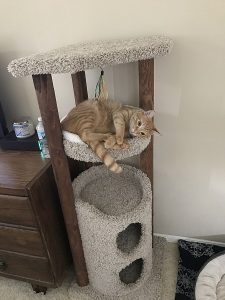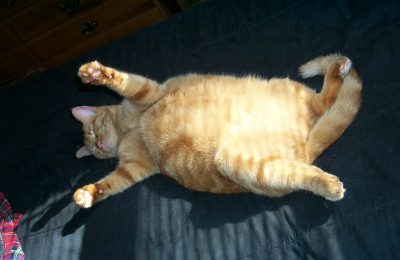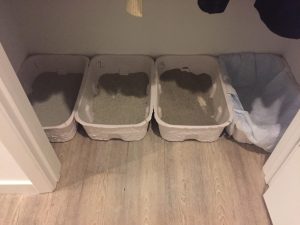
I think most of us are aware that chronic stress can take its toll on our health; it can reduce our immune responding, and lead to long-term inflammatory responses, and can even increase our susceptibility to cancer. Recognizing this link, humans make efforts to decrease stress, via meditation or relaxation techniques, exercise, therapy, meds, and by directly addressing the source of the stress, when possible.
But our cats don’t always have the choice to manage the stressors in their environment, and stress reduction techniques (such as exercise) may depend on what their humans provide for them. Being dependent on humans also means that cats are dependent on their owners recognizing that they are stressed in the first place!
Unfortunately, stress can manifest in health issues in cats too. One of the most common health issues associated with stress in cats is feline idiopathic cystitis (FIC). In this case, a cat has clinical lower urinary tract signs (LUTS) such as straining to urinate, urinating outside the litter box, or blood in the urine but diagnostics cannot determine a specific cause for the signs (the term idiopathic means disease or condition of unknown cause).
A cat who presents with LUTS is likely experiencing some form of stress. But how do we know what the stressors might be? A recent study, “Epidemiological study of feline idiopathic cystitis in Seoul, South Korea,” sought to determine what factors were related to a higher risk of FIC in cats who live in South Korea. The researchers interviewed owners of 58 cats who had been diagnosed with FIC, as well as 281 owners of control cats who had never had symptoms of FIC. The questions were focused on the cat’s living environment, behavior, and diet as well as questions about the litter box set up.
Based on the records of over 4000 cats in one practice, almost 3% of cats presented with LUTS and more than half of those cats were diagnosed with FIC, suggesting an overall prevalence of FIC of 1.77%. The researchers used statistical analyses to look for relationship between certain aspects of the cats’ environments and behavior and the likelihood of being diagnosed with FIC. This basically involves comparing the number of FIC cats who lived in an environment with a particular feature (such as other cats or outdoor access) compared with control cats.

The results suggested five key factors that were related to FIC: being male, having a litter box with non-clumping litter, living with other cats, living in an apartment (versus a house), and not having an elevated vantage point for use (such as a cat condo or vertical space).
So, for example, although there were equal numbers of male and female cats in the control group, males made up almost 76% of the FIC cats. This means that male cats were 2.34 times as likely to be diagnosed with FIC compared to female cats. The effect was strongest in cats who did not have a vantage point in the home, who were 4.64 times as likely to have FIC compared to cats with a vantage point.
Some other things seemed to contribute to FIC, although the relationship wasn’t as strong, such as shared food bowls, whether cats had access to a hiding space, and being middle aged. These are risk factors that merit more careful consideration in future studies.
Things that did not appear to be related to the likelihood of a diagnosis of FIC in this study included the style of the litter box (covered or uncovered), the number of people in the home, and having access to the outdoors.
We would be naïve to think that stress only impacts the urinary system in cats. It’s likely related to several other disease processes, and studies like the current one help us paint a picture of what causes stress in cats overall, even though it can’t necessarily tell us what will stress out YOUR cat. That’s up for you to do your best to understand and prevent, based on what you know about your cat and by providing him or her with things that make the environment safer, more engaging, and by giving your cat a sense of control via choices (in other words, an abundance of desirable resources!).
Living with other cats or not having a vantage point is not a guarantee that a cat will develop FIC, they are just risk factors. It’s possible that there are interaction effects, where cats who live with other cats are just fine if they have a vantage point, or the risks of being male increase if you also use a non-clumping litter. Plenty of cats may cope just fine with living in an apartment, but knowing these risks, we should do what we can to reduce their effects. By providing your cat with a vantage point, and adequate resources, it is possible we can remedy situations that might lead to stress in the first place – and with the added benefit of possibly reducing the risks of disease.
Reference
Kim, Y., Kim, H., Pfeiffer, D., & Brodbelt, D. (2017). Epidemiological study of feline idiopathic cystitis in Seoul, South Korea. Journal of feline medicine and surgery, 1098612X17734067.




One thought on “Stress and your cat’s health – a new study explores the connection”